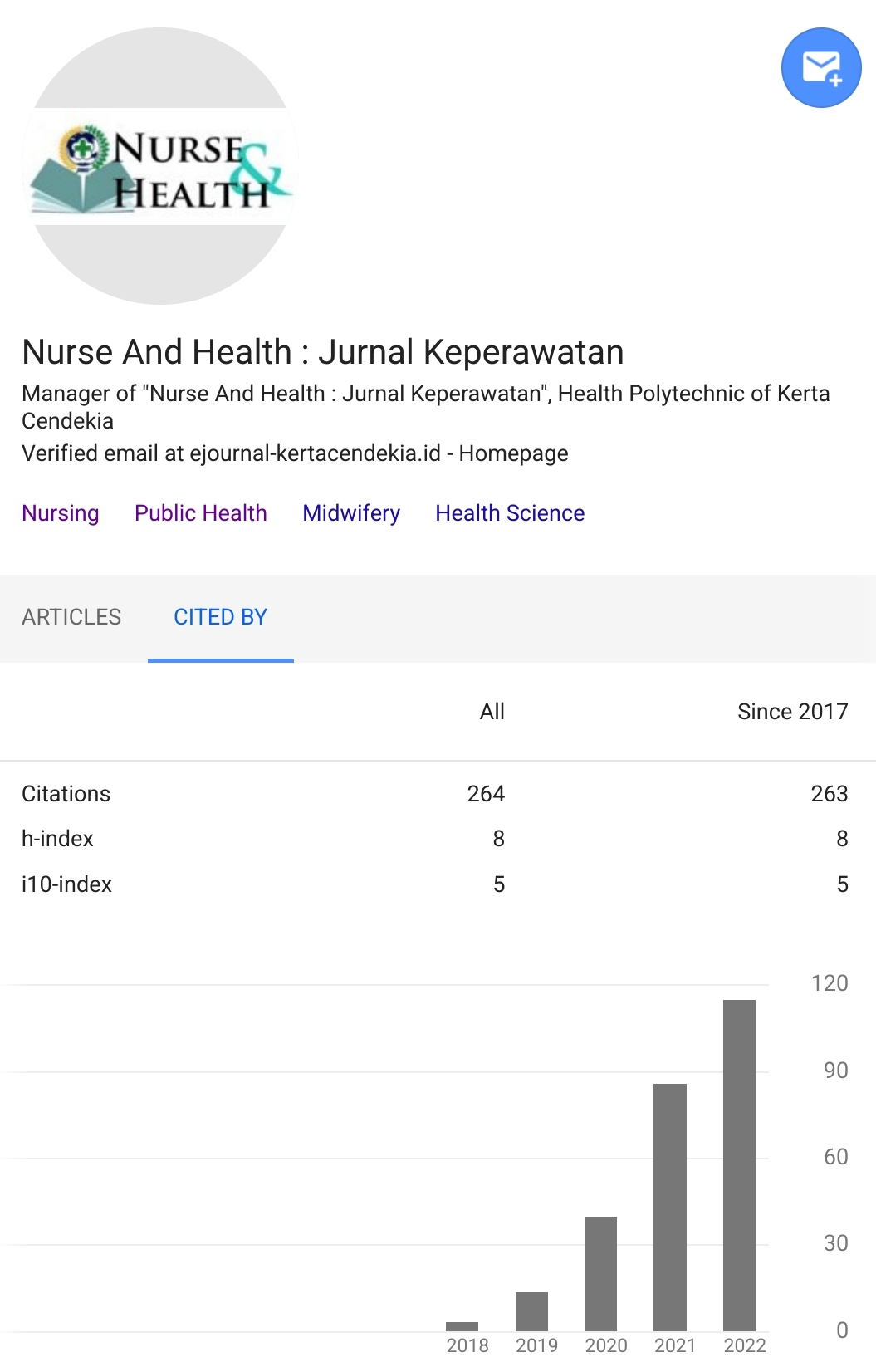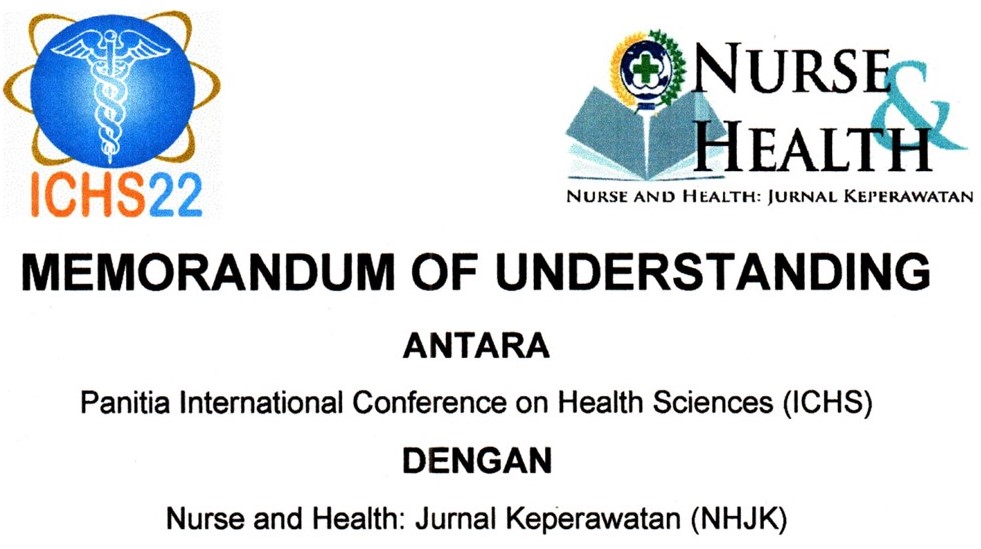EFFECT OF ALOE VERA EXTRACT AND DISCHARGE PLANNING TO ACCELERATE WOUND HEALING OF OLDER ADULT HERNIA SURGERY PATIENTS
Abstract
Background: Older adult patients who underwent hernia surgery commonly get obstacles in the process of wound healing as a result of decline of body functions. Aloe vera which contains of anti-inflammatory, anti-microbial and skin fibroblasts stimulator, can be used as adjunctive therapy in treating wounds.Objective: This study aimed to identify the effect of aloe vera extract and discharge planning to accelerate wound healing of older adult hernia surgery patients at dr. R. Soedarsono General Hospital, Pasuruan.Method: This study uses Quasi-Experimental with Static-group comparison approach. The population is all post-operative hernia patients aged 55-65 years at the operating room of dr. R. Soedarsono General Hospital, Pasuruan. The sample consists of 20 respondents taken according to the inclusion criteria. The independent variable is the treatment of wounds using aloe vera extract accompanied by discharge planning, while the dependent variable was the acceleration of wound healing especially inflammatory and proliferation phases. The data were collected through observation of macroscopic current wound care. Data were analyzed using nonparametric Mann Whitney test with significance level of < 0.05.Result: The results showed the effect of the treatment using aloe vera extract and discharge planning to accelerate wound healing of older adult hernia surgery patients, the inflammatory phase of healing occurs on the sixth day for inflammation, exudation, and edema (p = 0.022, p = 0.028, and p = 0.029, respectively). The proliferative phase occurs on day three with p = 0.015.Conclusion: This research indicates further research on the benefits of aloe vera and discharge planning for wound healing especially in older adult patients is required. Thus, a stronger basis for recommending aloe vera extract as complementary therapy for wound care is available. Key words: Aloe Vera, Discharge Planning, Surgical Wound, Older Adults Age.Downloads
References
Afandi, M.F. (2011). Kemampuan Penyembuhan Luka dengan Lidah Buaya. Retrieved from http://kesehatan.kompasiana.com/alternatif/2011/01/01/kemampuan-penyembuhan-luka-pada-aloevera.
Akhoondinasab, M.R., Akhoondinasab, M., Saberi, M. (2014). Comparison of healing effect of aloe vera extract and silver sulfadiazine in burn injuries in experimental rat model. World journal of plastic surgery, 3(1), 29.
Aminuddin. (2009). Prinsip Dasar Penyembuuhan Luka. Retrieved from http://aminetn. Wordpress.com/2009/07/26/prinsip dasar-penyembuhan-luka/
Atiba, A., Nishimura, M., Kakinuma, S., Hiraoka, T., Goryo, M., Shimada, Y., Uzuka, Y. (2011). Aloe vera oral administration accelerates acute radiation-delayed wound healing by stimulating transforming growth factor-β and fibroblast growth factor production. The American Journal of Surgery, 201(6), 809-18.
Atik, N. dan Iwan J. (2009). Perbedaan Efek Pemberian Topikal Gel Lidah Buaya (Aloe vera L.) dengan Solusio Povidone Iodine terhadap Penyembuhan Luka Sayat pada Kulit Mencit (Mus musculus). MKB. 2009:8:2:87-93.
Banu, A., Sathyanarayana, B., & Chattannavar, G. (2012). Efficacy of fresh Aloe vera gel against multi-drug resistant bacteria in infected leg ulcers. The Australasian medical journal, 5(6), 305.
Chithra, P., Sajithlal, G.B., & Chandrakasan, G. (2008). Influence of Aloe Vera on Collagen Characteristics in healing Dermal Wounds in Rats. Mol-Cell-Biochem, 181(1-2), 71-76.
Cowsert, Lex, M. (2010). Biological Actifities of Acemannan. Retrieved from http://www.symmetrydirect.com/pdf/Bioactivofacemannan.pdf.
Choonhakarn, C., Busaracome, P., Sripanidkulchai, B., Sarakam, P. (2010). A Prospective, randomized clinical trial comparing topical aloe vera with 0.1% triamcinolone acetonide in mild to moderate plaque psoriasis. Journal Eur Acad Dermatol Venereol, 24(2), 168-72
Dal’Belo, S.E., Gaspar, L.R., Maia, Campos, P.M. (2006). Moisturizing effect of cosmetic formulations containing Aloe vera extract in different concentrations assessed by skin bioengineering techniques. Skin Research Technol, 12(4), 2441-6.
Das, S., Mishra, B., Gill, K., Ashraf, M.S., Singh, A.K., Sinha, M., Singh, T.P. (2011). Isolation and characterization of novel protein with anti-fungal and anti-inflammatory properties from Aloe vera leaf gel. International Journal of Biological Macromolecules, 48(1), 38-43.
Departemen Kesehatan RI. (2010). Izin dan Penyelenggaraan Praktik Perawat, Permenkes republic Indonesia No HK.02.02/Menkes/148/2010. Pasal 8.
Egesie, U., Chima, K., & Galam, N. (2011). Anti-inflammatory and analgesic effects of aqueous extract of Aloe Vera (Aloe barbadensis) in rats. African Journal of Biomedical Research, 14(3), 209-12.
Eshghi, F., Hosseinimehr, S.J., Rahmani, N., Khademloo, M., Norozi, M.S., & Hojati, O. (2010). Effects of Aloe vera cream on posthemorrhoidectomy pain and wound healing: results of a randomized, blind, placebo-control study. The Journal of Alternative and Complementary Medicine, 16(6), 647-50.
Furnawanthi, I. (2006). Khasiat & Manfaat Lidah Buaya Si Tanaman Ajaib. Purworejo: Agro Media Pustaka.
Hosseinimehr, S.J., Khorasani, G., Azadbakht, M., Zamani, P., Ghasemi, M., & Ahmadi, A. (2010). Effect of aloe cream versus silver sulfadiazine for healing burn wounds in rats. Acta Dermatovenerologica Croatica, 18(1), 0-0.
Hutter, J.A., Salman, M., Stavinota, W.B., Satsangi, N., Williams, R.F., Streeper, R.T., & Weintraub, S.T. (2006). Antiinflammatory C-glucosyl Chromone from Aloe Barbadensis. J-Nat-Pro, 59(5), 541-543.
Irshad, S., Butt, M., & Younus, H. (2011). In-vitro antibacterial activity of Aloe barbadensis Miller (Aloe vera). International research journal of pharmaceuticals, 1(2), 59-64.
Ismail. (2007). Luka dan Perawatannya. Retrieved from http://images. Mailmkes.multiply.multiplaycontent.com/attachment/0/RDd@AoKCEMAADk5LMI1/Merawat %20luka.pdf?nmid=88915450 on November 20th, 2011.
Junquiera, L.C., Carneiro J. (2007). Basic Histology: Text and Atlas. (Edisi ke-11). New York: McGraw-Hill.
Khorasani, G., Hosseinimehr, S.J., Azadbakht, M., Zamani, A., & Mahdavi, M.R. (2009). Aloe versus silver sulfadiazine creams for second-degree burns: a randomized controlled study. Surgery today, 39(7), 587-91.
Kumar, V., Abbas, A.K., Fausto, N., Aster, J.C., Robbins, and Cottrans. (2010). Pathologic Basis of Disease. (8th ed) . Philadelphia: Saunders Elsevier.
Kathuria, N., Gupta, N., Manisha, R., Prasad, R., Nikita. (2011). Biologic Effects of Aloe Vera Gel. The Internet Journal of Microbiology, 9, 2.
Kurniawan, H. (2007). Efek Daun Kelor (Moringa Oleifera) dalam Mempercepat Penurunan Tanda Inflamasi Eritema pada Luka Bersih pada Marmut (Cavia Porcellus). The Indonesian Journal of Health Science, 1(1), 23-31.
Kozier, B. et al. (2008). Fundamental of Nursing: Concepts, Process and Practice. New Jersey. Pearson Education.
Marriner-Tomey & Alligood. (2010). Nursing Theorists and Their Works. (7th ed.) St.Louis: Mosby Elsevier, Inc.
Mansjoer Ali, Kuspuji T., Rakhmi S., Wahyu Ika, Wiwik S.W. (2014). Kapita Selekta Kedokteran. (edisi 4). Jakarta: Media Aesculapius.
Mendonça, F.A.S., Passarini Junior, J.R., Esquisatto, M.A.M., Mendonça, J.S., Franchini, C.C., & Santos, G.M.Td. (2009). Effects of the application of Aloe vera (L.) and microcurrent on the healing of wounds surgically induced in Wistar rats. Acta Cirúrgica Brasileira, 24(2), 150-55.
Nursalam. (2011). Manajemen Keperawatan: Aplikasi dalam Praktik Keperawatan Profesional Edisi 3. Jakarta: Salemba Medika.
Nugroho, W. (2008). Keperawatan Gerontik & Geriatrik. (ed 3). Jakarta, EGC.
Oryan, A., Naeini, A.T., Nikahval B., Gorjian, E. (2010). Effect of aqueous extract of Aloe vera on experimental cutaneous wound healing in rat. Veterinarski arhiv, 80(4), 509-22.
Oyelami, O.A., Oneyami, A., Oyedeji, O.A., & Adeyemi, L.A. (2009) Prelilminary Study of Effectiveness of Aloe Vera in Scabies Treatment. Journal Phytotheraphy Research, 23(10), 144882-4.
Pellizzoni, M., Ruzickova, G., Kalhotka, L., Lucini, L. (2012). Antimicrobial activity of different Aloe barbadensis Mill. and Aloe arborescens Mill. leaf fractions. Journal of Medicinal Plants Research, 6(10), 1975-81.
Ramamoorthy, L., Kemp, M.C., Tizard, I.R., Ramamoorthy, L., Kemp, M.C., & Tizard, I.R. ( 2011). Acemannan, beta-(1,4)-asetat Mannan, menginduksi produksi oksida nitrat dalam baris sel makrofag RAW 264,7. Retrieved from http://www.ncbi.nlm.nih.gov/pubmed/8863833 on April, 25th 2012.
Setiabudi, A.W. (2008). Lidah Buaya. Retrieved from http//www.artikel-lidah-buaya/pages.htm on September 9th, 2011.
Sjamsuhidajat, R., & Jong, W.D. (2011). Buku Ajar Ilmu Bedah Edisi ke 3. Jakarta: EGC.
Smeltzer, S., & Bare, C. (2010). Brunner & Suddarth’s Textbook of Medical Surgical Nursing 12th Edition. Philadelphia : Lippincott Williams & Wilkins.
Sukmono, J. (2006). Pedoman Terapi Herbal. Jember: Sanggar Meditasi dan Tanaman Obat "Adem Ati".
Schwartz, S.I., Brunicardi, F.C., Anderson, D.K., Billiar, T.R., Dunn, D.L., Hunter, J.G., Mathews, J.B., & Pollock, R.E. (2010). Schwartz's Principles of Surgery Ninth Edition. New York: McGraw Hill Professional.
Tamher, S., & Noorkasiani. (2009). Kesehatan Usia Lanjut dengan Pendekatan Asuhan Keperawatan. Jakarta.
Widagdo, T.D. (2010). Perbandingan Pemakaian Aloe Vera 25%, 40% dan Silver Sulfadiazine 1% Topikal pada Penyembuhan Luka Bakar Derajad II. Retrieved from http://eprints.undip.ac.id/21436/
Wilksman, L.B., Solomonik, I., Spira, R., Tennenbaum, T. (2007). Novel Insights into Wound Healing Sequence of Events. Toxicologic Pathol, 35, 767-79.
Zakariya, M. (2008). Efektifitas Penggunaan Madu dibandingkan Povidone Iodine 10% terhadap Penyembuhan Luka Insisi pada Marmut (Cavia Cobaya). Unpublished thesis by Faculty of Nursing, Airlangga University, Surabaya.
Authors who publish with Nurse and Health: Jurnal Keperawatan agree to the following terms:
- Authors retain copyright licensed under a Creative Commons Attribution-NonCommercial 4.0 (CC BY-NC 4.0), which allows others to remix, tweak, and build upon the authors' work non-commercially, and although the others' new works must also acknowledge the authors and be non-commercial, they don't have to license their derivative works on the same terms.
- Authors are permitted and encouraged to post their work online (e.g., in institutional repositories or on their website) prior to and during the submission process, as it can lead to productive exchanges, as well as earlier and greater citation of published work (See The Effect of Open Access). Authors can archive pre-print and post-print or publisher's version/PDF.








_resize1.jpg)















